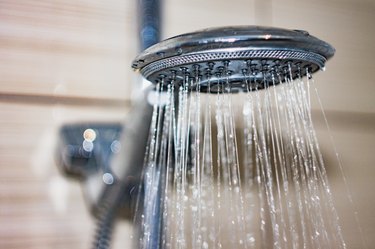If you notice a sudden drop in pressure, the cause may be in your plumbing system or in the water supply to your house. You can't do anything about the supply pressure if you're on a municipal system, but you can if you're on a well. When you have no water pressure at a particular faucet, diagnosis starts by checking other faucets to see if the problem is confined to a single fixture or a particular part of the house or if it affects the whole house.

Video of the Day
No Water Pressure at a Single Faucet or in a Single Room
When you suddenly lose pressure at a single faucet, and pressure is normal at all the others, the fault is probably in the faucet. If the faucet is old, and you have hard water, a piece of scale may have broken off and blocked one of the water ports. You can usually find the problem by disassembling the faucet, but before you do that, unscrew and clean the aerator. Nine times out of 10, that will fix the problem.
Video of the Day
If the loss of pressure occurs in an entire bathroom or part of the house but nowhere else, you can usually trace that to the plumbing pipes. Chances are you have galvanized steel pipes, and these corrode with time, gradually restricting water flow. At some point, a piece of rust may have broken off and gotten lodged in a particularly narrow part of the pipe, and that's what caused your sudden loss of pressure. You'll need a plumber to correct this problem.
Municipal Water Supply Causing Whole House Pressure Drop
If you suddenly have no water pressure in the entire house, that could be caused by a glitch in the water supply system — perhaps a broken water main several blocks away or by your own pressure regulator. To test the regulator, you'll need a pressure meter that screws onto a laundry or outdoor faucet.
Screw the meter onto a faucet, open the faucet all the way and check the pressure. Open the pressure regulator, which is usually located by the water meter in the basement or outside, by turning the nut counterclockwise about a quarter turn with a wrench.
The pressure should increase slightly but not by much. If it jumps more than 20 psi, the pressure regulator probably needs to be replaced. If the pressure doesn't change at all no matter how much you turn the nut, the problem is on the supply side. Be sure to return the nut to its original position when you conclude this test.
No Water Pressure in a House Served by a Well
If you get your water from a well, and you get a sudden pressure drop, check the pressure gauge on the pump. If it's below the pump's cut-in value, which is usually about 30 psi, and the pump isn't pumping, check for a tripped breaker and reset it. If you don't find a tripped breaker, call a plumber.
If the pump is running, but the gauge doesn't seem to be climbing, there could be a leak in the system or the pump may have blown a seal, so shut off the pump to prevent it from overheating. If there's a leak, it's usually easy to find but not necessarily if the section of the pipe that broke is underground. A patch of soggy ground may give away its location, but you may have to call a plumber to help you find and fix it. The plumber can also service or replace the pump if it has a bad seal.